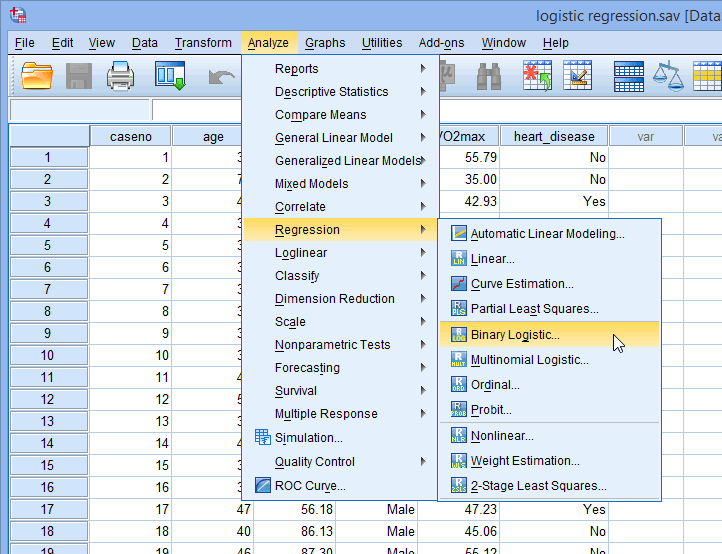


Examples of dichotomous variables include gender (two groups: "males" and "females"), presence of heart disease (two groups: "yes" and "no"), personality type (two groups: "introversion" or "extroversion"), body composition (two groups: "obese" or "not obese"), and so forth. Assumption #1: Your dependent variable should be measured on a dichotomous scale.First, let's take a look at some of these assumptions: Even when your data fails certain assumptions, there is often a solution to overcome this.
BINARY LOGISTIC REGRESSION SPSS HOW TO
This is not uncommon when working with real-world data rather than textbook examples, which often only show you how to carry out binomial logistic regression when everything goes well! However, don’t worry. In practice, checking for these seven assumptions just adds a little bit more time to your analysis, requiring you to click a few more buttons in SPSS Statistics when performing your analysis, as well as think a little bit more about your data, but it is not a difficult task.īefore we introduce you to some of these assumptions, do not be surprised if, when analysing your own data using SPSS Statistics, one or more of these assumptions is violated (i.e., not met). You need to do this because it is only appropriate to use a binomial logistic regression if your data "passes" seven assumptions that are required for binomial logistic regression to give you a valid result. When you choose to analyse your data using binomial logistic regression, part of the process involves checking to make sure that the data you want to analyse can actually be analysed using a binomial logistic regression. However, before we introduce you to this procedure, you need to understand the different assumptions that your data must meet in order for binomial logistic regression to give you a valid result. This "quick start" guide shows you how to carry out binomial logistic regression using SPSS Statistics, as well as interpret and report the results from this test. Alternately, you could use binomial logistic regression to understand whether drug use can be predicted based on prior criminal convictions, drug use amongst friends, income, age and gender (i.e., where the dependent variable is "drug use", measured on a dichotomous scale – "yes" or "no" – and you have five independent variables: "prior criminal convictions", "drug use amongst friends", "income", "age" and "gender"). Alternatively, if you have more than two categories of the dependent variable, see our multinomial logistic regression guide.įor example, you could use binomial logistic regression to understand whether exam performance can be predicted based on revision time, test anxiety and lecture attendance (i.e., where the dependent variable is "exam performance", measured on a dichotomous scale – "passed" or "failed" – and you have three independent variables: "revision time", "test anxiety" and "lecture attendance"). If, on the other hand, your dependent variable is a count, see our Poisson regression guide. Binomial Logistic Regression using SPSS Statistics IntroductionĪ binomial logistic regression (often referred to simply as logistic regression), predicts the probability that an observation falls into one of two categories of a dichotomous dependent variable based on one or more independent variables that can be either continuous or categorical.


 0 kommentar(er)
0 kommentar(er)
